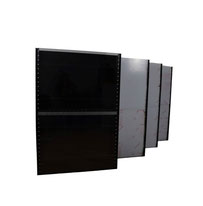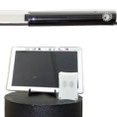Rhizotrons & Root Observation Windows
Rhizotron facilities commonly incorporate (plexi-)glass observation windows / panels for the observation of root growth in undisturbed soil. This concept has also been adapted for field research, where (removable) "root windows", as an alternative to "minirhizotrons", are employed to achieve the same purpose. For "portable" rhizotrons and ex situ studies, please see Rhizoboxes (= "small", portable Rhizotrons).
Rhizotrons for large scale soil and root experiments' ex situ, custom-made

Rhizotrons. We build ultra-large rhizoboxes, also known as mobile rhizotrons. They are used for woody plant studies, as mesocosms for holding species assemblages, and for educational displays. The Rhizotrons are fully customizable and consist of (perforated) aluminium panels (anodized) for the back and/or sides, aluminium profiles on the (front) edges, and transparent acrylic front (and/or rear) panels (mounted straight or angled). The bottom of the rhizotron can be open ("no bottom") or perforated (for drainage). Shading panels or roller blinds are optional, but recommended if the growing facility has natural light. Mobile Rhizotrons "on wheels" and with openings for sensors or partially removable panels / entry holes for sampling and manipulation (e.g. for soil water sampling) can be realized for research purposes according to customer specifications. Mobile Rhizotrons have several advantages over classical Rhizotron facilities (see bottom of page), including
- significantly lower set-up costs,
- can be filled more easily with different soil types, can be used for
- independent, replicated experimental treatments (irrigation, fertilization, ...), and
- units are exchangeable.
The latter is particularly important when the mobile rhizotrons are used for educational or promotional displays, where the "demonstration material" must always be available - otherwise defying the purpose. However, similar to a classical Rhizotron facility in situ, the plant root growth in mobile Rhizotrons is relatively unrestricted, especially at depth (read more on "pot" size limitations on plant growth). Read below on large scale underground laboratories, classically known as walk-in Rhizotrons. Please contact us to discuss your custom-made, mobile Rhizotron installation.
Mobile Rhizotron - Features
- Large scale experimentation and/or educative display of roots, rhizosphere, bulk soil
- Mobile, flexible experimental set-ups
- Long lasting, stainless materials
- Fully customized in size, geometry, sensor openings
Options:
- Wheels and stainless metal frame - for enhanced mobility of free standing units in greenhouses
- Light exclusion mechanism integrated (roller blinds or shading panels)
- Partially removable panels (/ panel sections)
- Matching soil moisture sensors and water samplers
- Bespoke respiration chamber, for gas flux measurements
Have a look at Rhizobox Experimental Root Monitoring Systems if you are interested in smaller, portable Rhizotron units for replicated studies in glasshouses or growth chambers. Rhizoboxes can be imaged (semi-)automatically.
Root Observation Window for Field Studies and Walk-in Rhizotron Facilities

Root Observation Windows, installed in walk-in "Rhizotron" facilities or on field plots, typically consist of a transparent panel or wall that is installed vertically (or slightly angled) in the soil to allow direct visualization of the roots and the rhizosphere. This panel is made of transparent & durable acrylic. The transparent surface is positioned to intersect the root zone, allowing to observe the roots as they grow and develop. Vienna Scientific will assist you in sourcing/manufacturing all parts necessary to install Root Observation Windows in your experiment or rhizotron research infrastructure. Our service can include
- Installation tools (such as metal plates to cut a slit in the soil)
- Root windows (custom sizes, acrylic (PMMA) or tempered glass), fixed or removable
- Support Frames (to secure the Root Window to the soil, custom based on soil conditions, root window dimensions, permanency of experimental set-up)
- Shading Panels / roller blinds (to cover and optionally provide additional support to large Root Window between observations)
Optional:
- Root windows with removable section or small holes, allowing to sample roots, extract soil water, etc.
- Covers to close excavated pits between observations
- Bottom mat to cover the bottom of excavated pits (to prevent feet from getting too dirty in muddy pits)
Wooden poles and boards to secure the excavated pit walls (back and sides) can best sourced locally: we support you on designing the reinforcement structure. Please schedule a meeting to discuss your root window requirements.
How to install a root observation window
- Installing root windows in a field generally involves the following steps ... Show more
-
- Cutting a soil profile by inserting a steel plate (or similar)
- Replacing the steel plate with a Plexiglas observation window
- Fixing / stabilising the observation window with a supporting frame, pressing the root window gently against the soil profile
- Excavating the area in front of the observation window (soil pit), reinforcing side walls, etc.
- Install shading panels, reinforce the walls of the soil pit against cave-ins, etc. Consider installing a drainage system in the soil pit. Consider installing a cover over the entire soil pit (reduces the risk of injury, and reduces the temperature at your root window).
- Wait for root systems to grow / grow back.
- Observe roots. If your Root Observation Window is removable, measure biochemical soil and rhizosphere properties (pH, exudation, etc.) in situ.
What is a Rhizotron facility?

A rhizotron, derived from the Greek verb "rhizóō / ῥιζόω" meaning "root" ("become stable"), refers historically to an underground laboratory for studying belowground processes, in particular soil and its relationships with plant (roots) and soil fauna. Within a Rhizotron facility, there is typically a central corridor or access room with vertical or slightly angled root observation windows or horizontally installed MR tubes that provide views into soil profiles.
- If the installation involves lysimeters (to determine soil hydraulic processes / water use in greater detail), they are also called Rhizolysimeters. External bays (or mobile rhizotrons) may be built to facilitate specific experiments by manipulating soil composition / irrigation, as well as the presence of plants and/or animals. Show more
-
Other rhizotron designs dont have a compartmentalized design but directly face towards experimental (agri-, aboricultural or forestry) plots. Minirhizotron cameras and rhizoboxes are essentially modern, more flexible versions of these classical underground research facilities - all have in common that roots and the rhizosphere (hypae, soil fauna) can be observed directly at a soil-(transparent)wall interface.
While the infrastructure costs to setup rhizotron facilities are often considerable, walk-in rhizotrons offer several advantages over other methods for studying roots, especially in cases where extensive measurements are needed. By performing successive measurements on the same plants, researchers can obtain rapid estimates of root growth at the root-soil interface. Unlike destructive methods (e.g. soil coring) that increasingly disturbe plots at each sampling period, using the same plants for consecutive measurements reduces the potential error caused by normal plant-to-plant variability. Rhizotrons have this, however, in common with the mini-rhizotron approach (in situ or in mesocosms) and partially with root boxes (ex situ; in disturbed soil). In addition, however, installing and maintaining instrumentation such as e.g. soil moisture sensors to measure soil or plant properties is easier in a permanent rhizotron facilties - allowing easier access to key infrastructure (water, electricity, internet connectivitiy, etc.) than field plots incl. root obervation windows, and long term studies. In addition, in a rhizotron, sensors / minirhizotron tubes can be conveniently installed horizontally from the walkway/access point, which can help to prevent water from flowing down or along the access hole(s), as often happens with not optimally installed sensors / MR tubes in a vertical position.
While some Rhizotron installations, see below for some historical and recent images of Rhizotron facilities, have been upgraded/rebuilt in recent years, the current focus of root researchers seem to have shifted to more mobile tools. It remains thus to be seen whether the challenges posed by advancing climate change on ecosystem functioning will lead to a renaissance of rhizotron research infrastructure.
Images are displayed for illustrative purposes only, were collected from various sources and copy rights remain with the respective owners.
| References | Root Observation Windows and Rhizotrons | OPEN |
|
||
We offer adapted, automated Rhizosphere Scanner Systems to continuously image A4-sized areas on field or rhizotron facility-installed root observation windows.
Consider the Minirhizotron Imaging System AC-19 (for horizontal use) in Rhizotron facilities / underground laboratories. Tubes must not be compressed or bend.
For experiments with soil - rice to natural wetlands - consider the standardized Rootboxes for waterlogging experimentation.

























